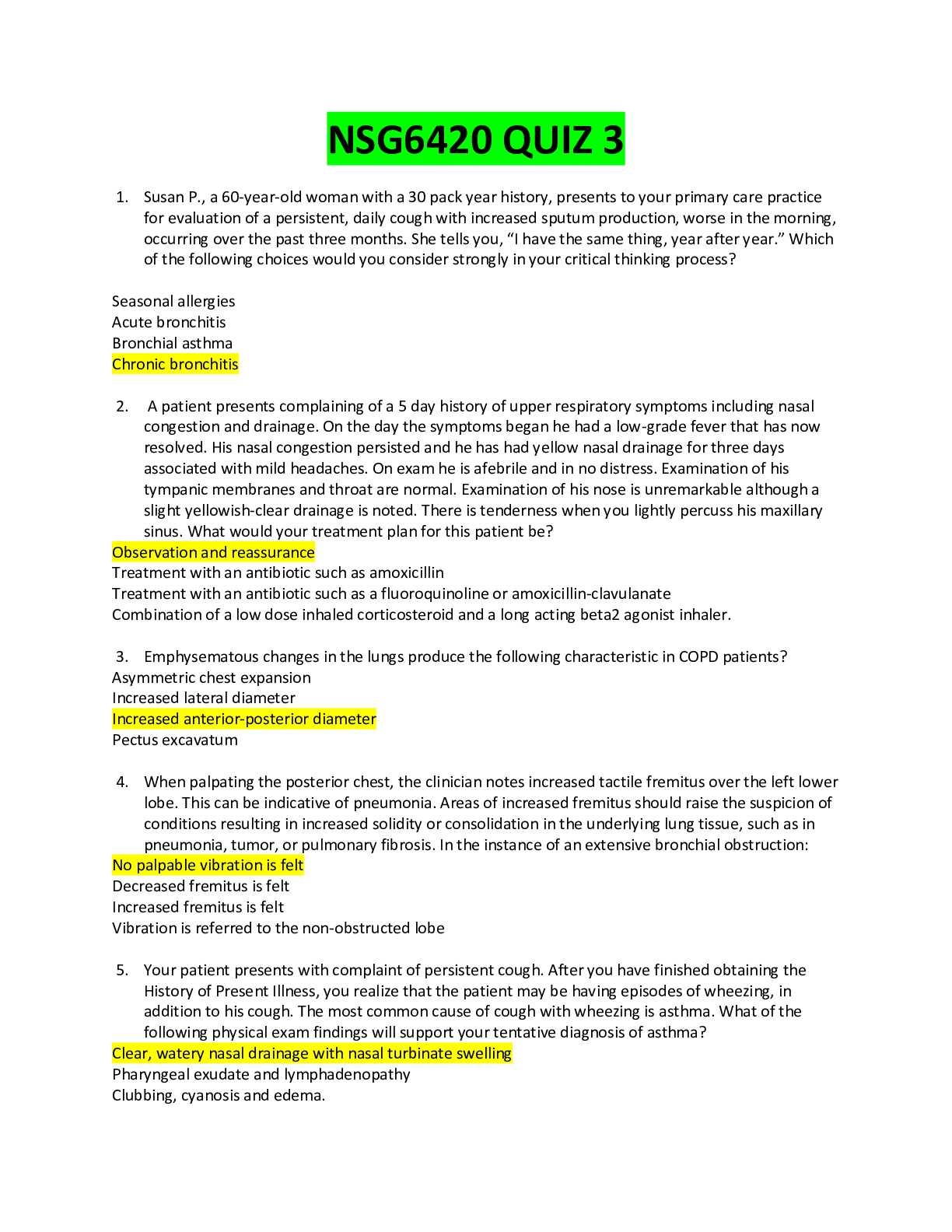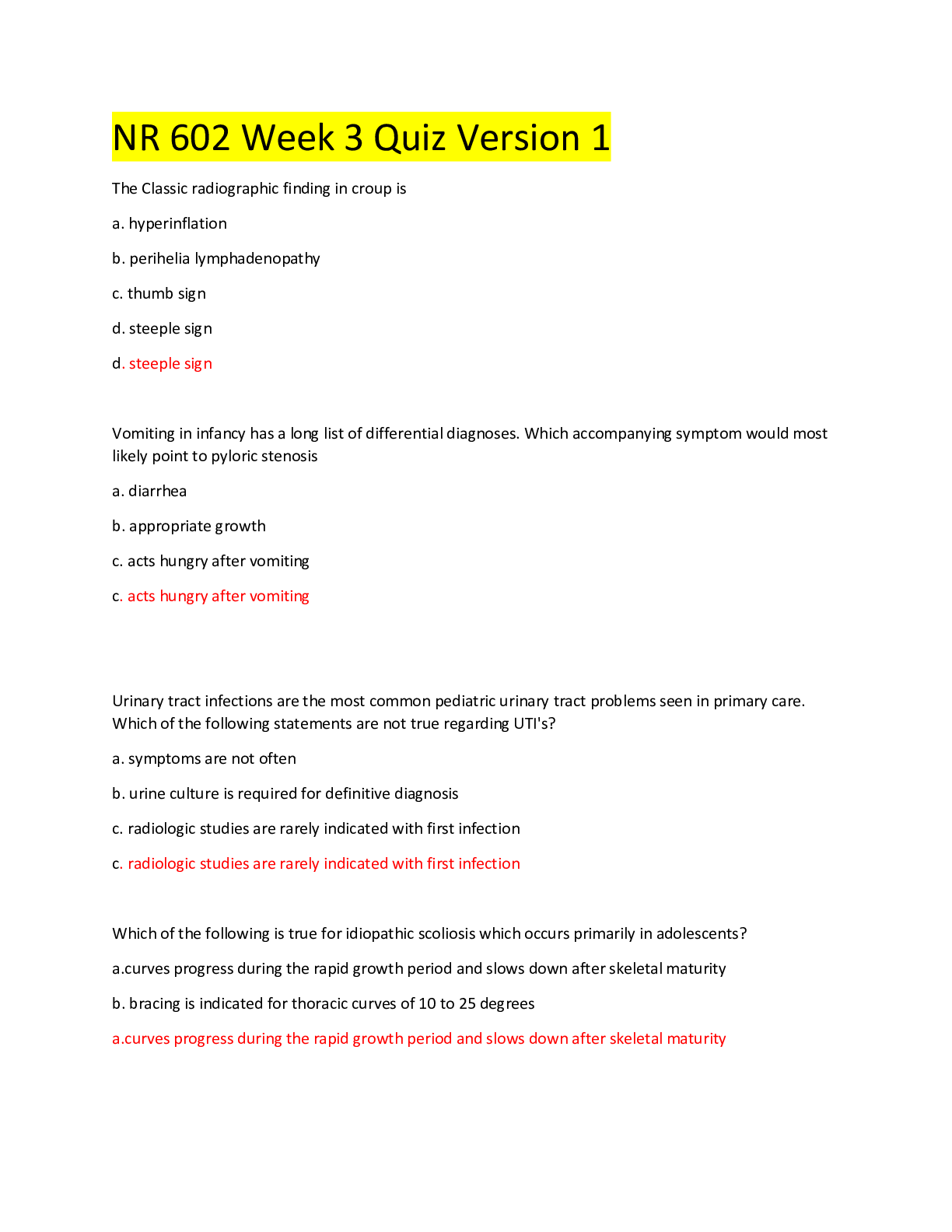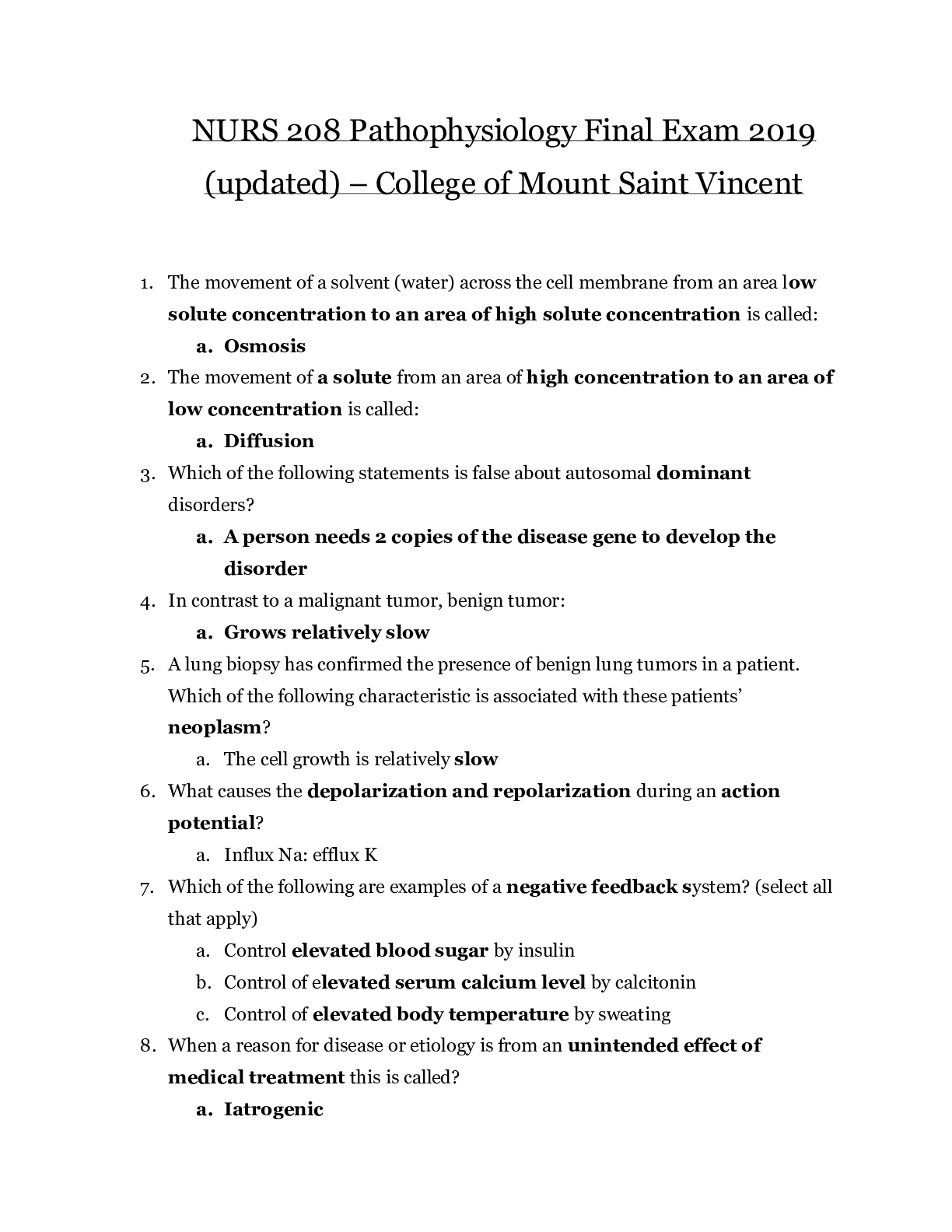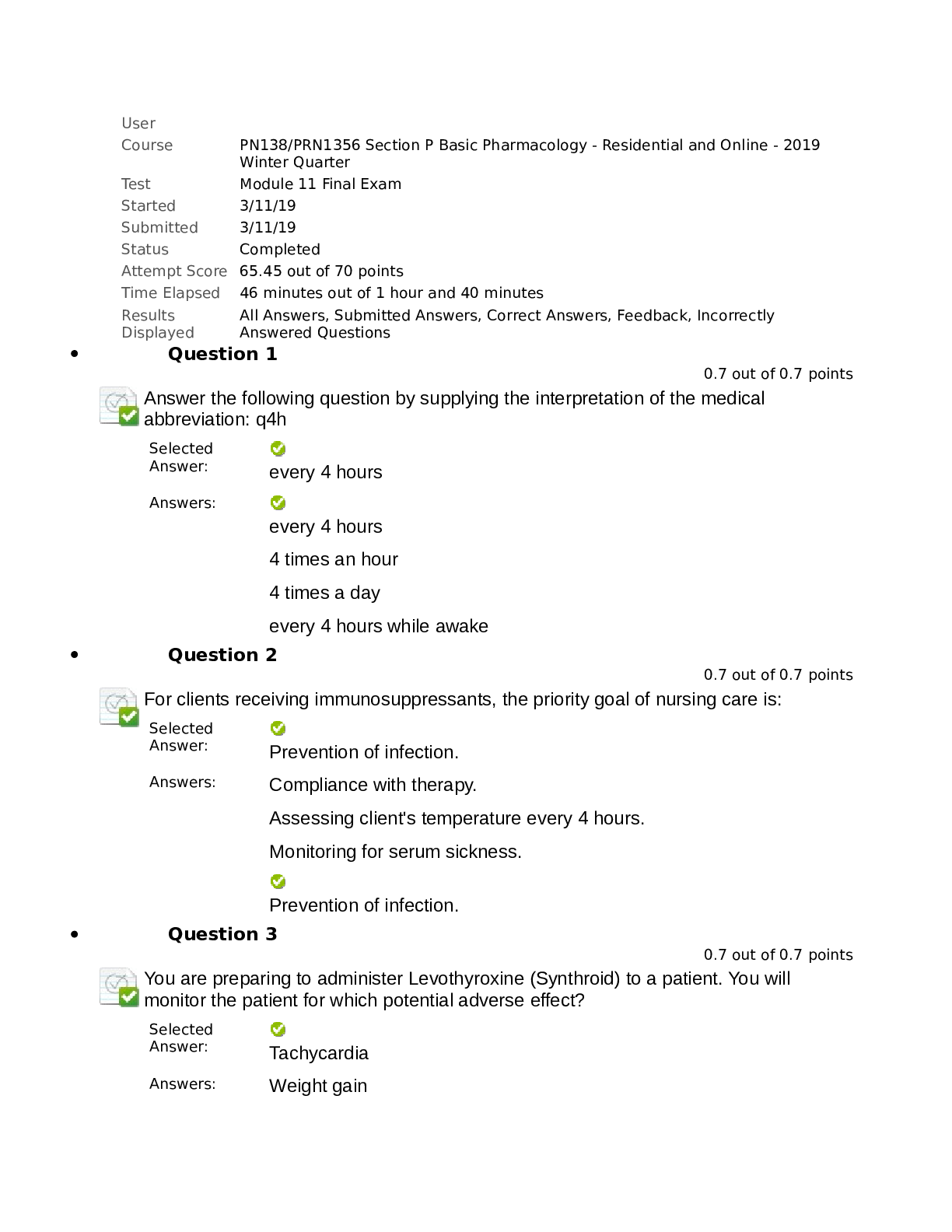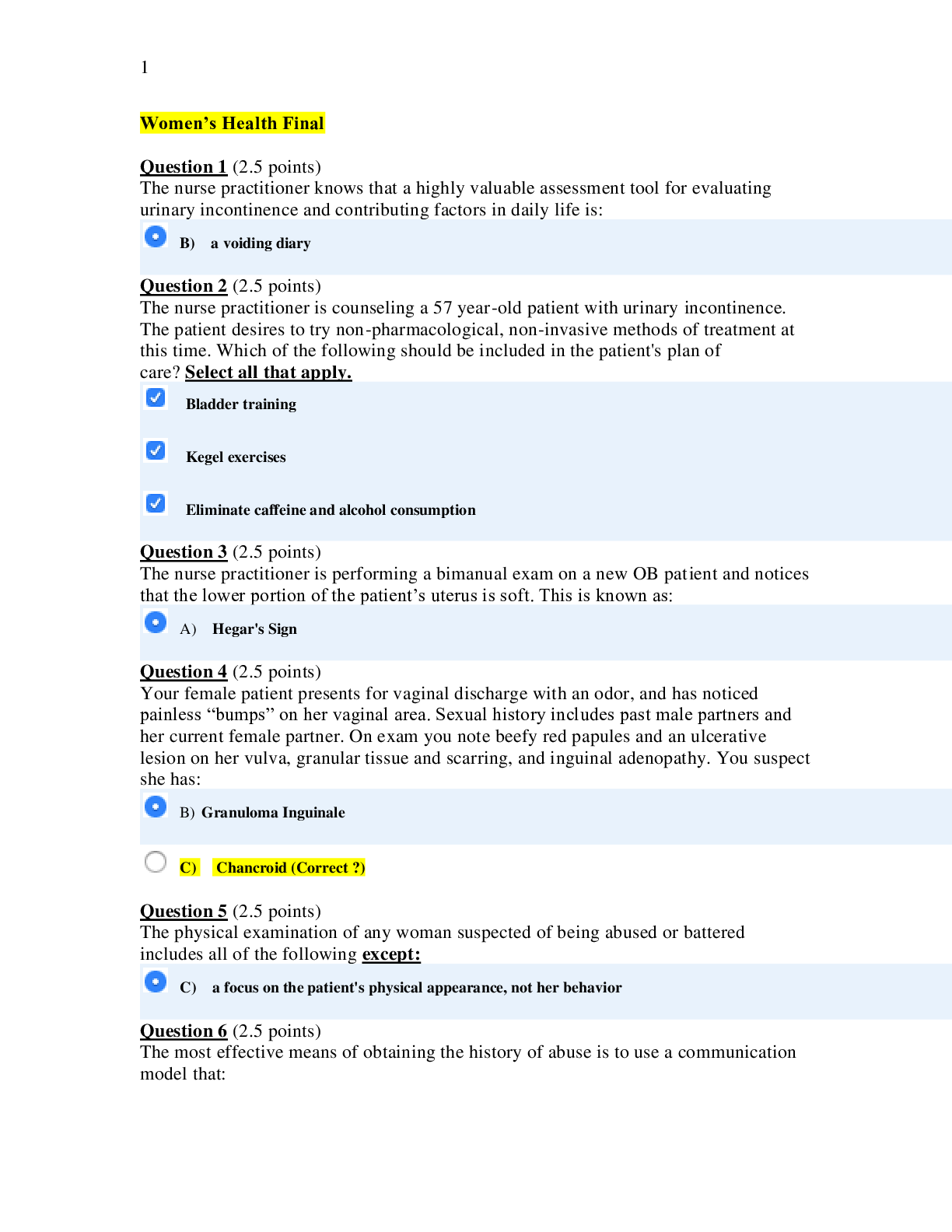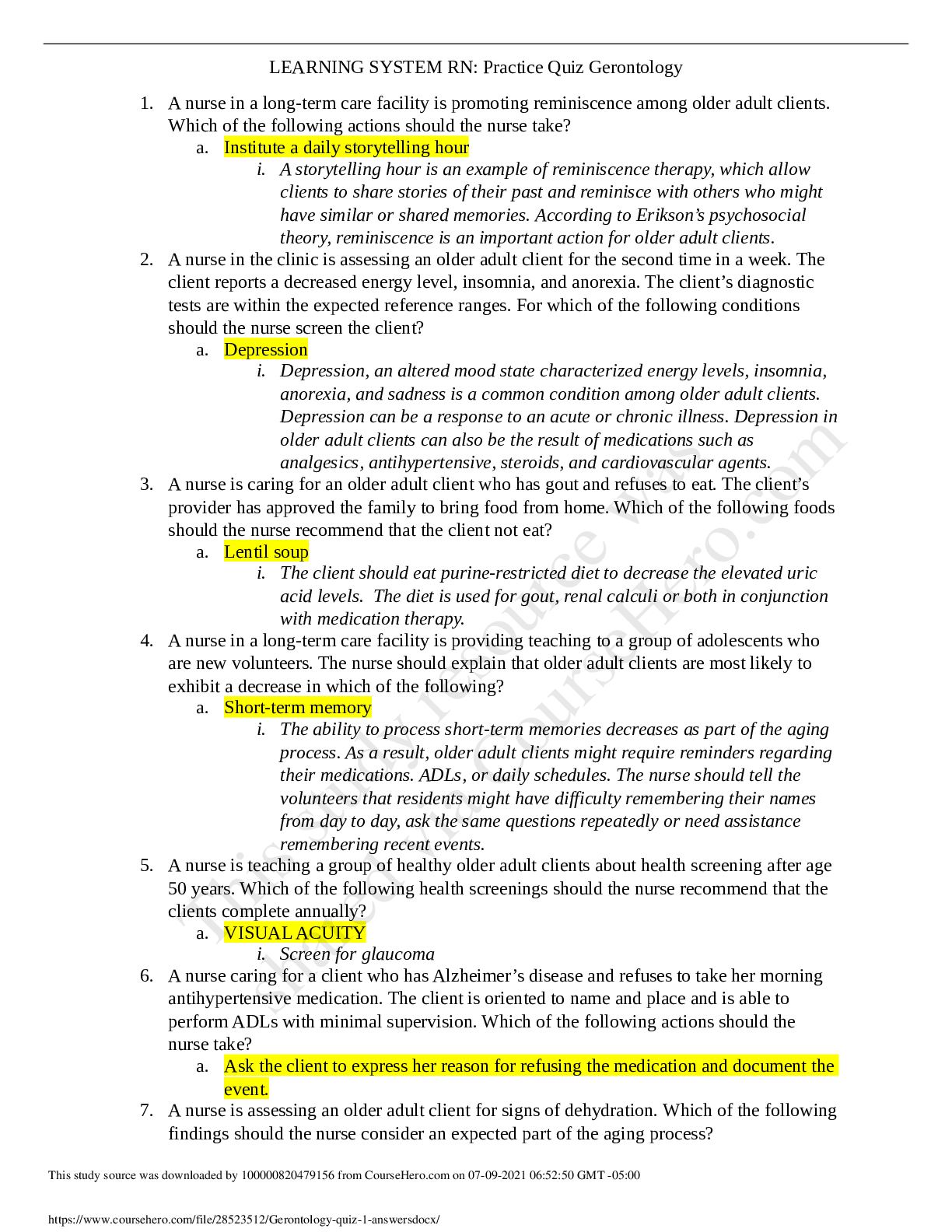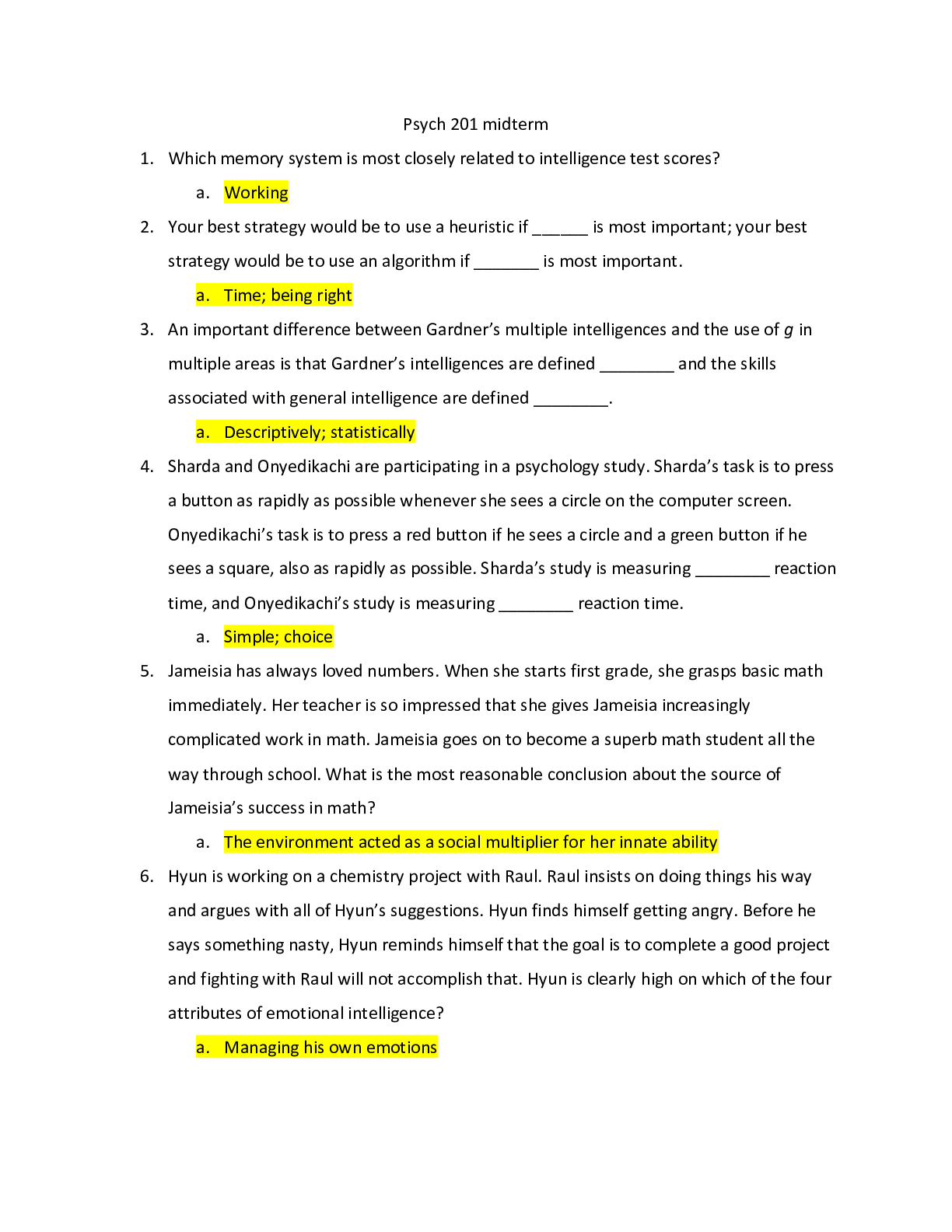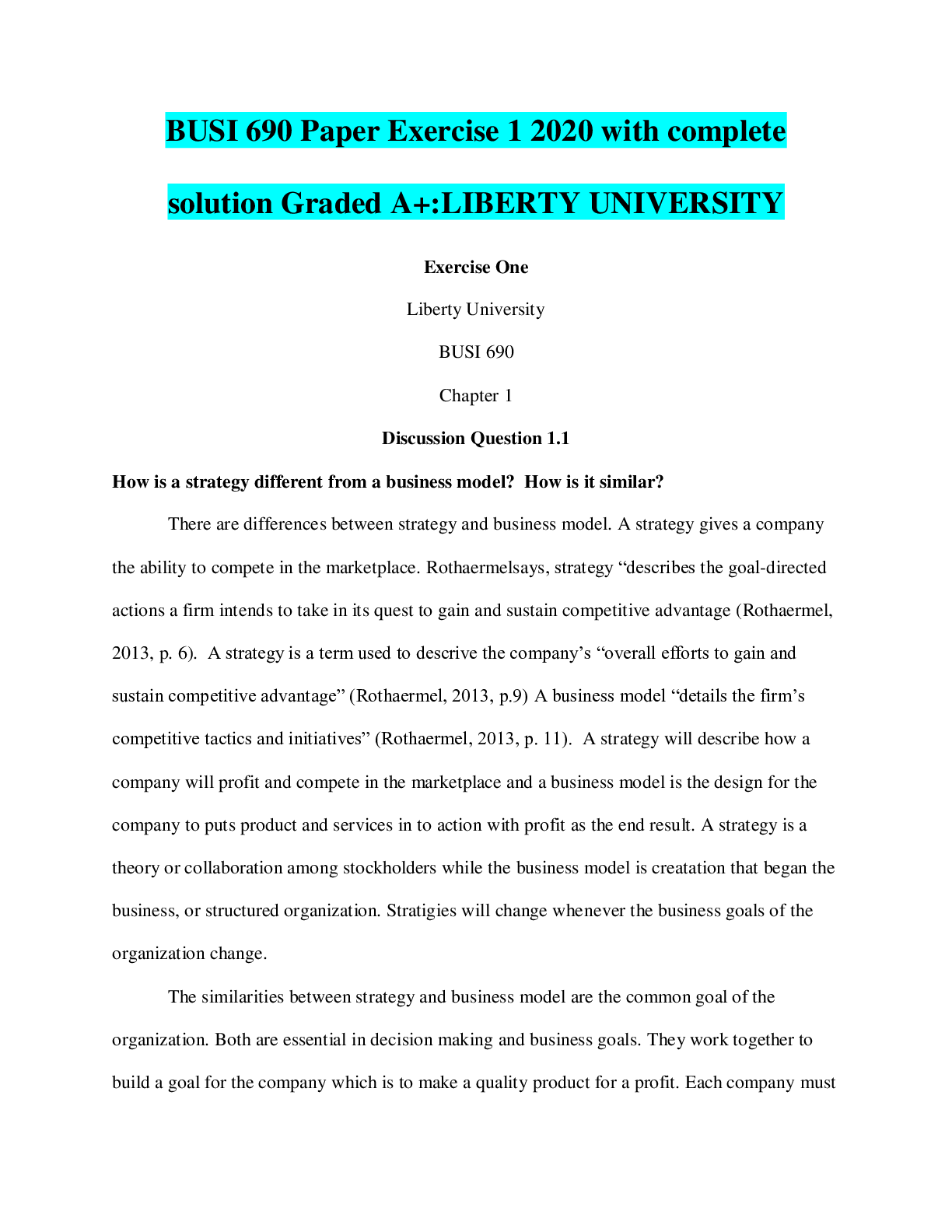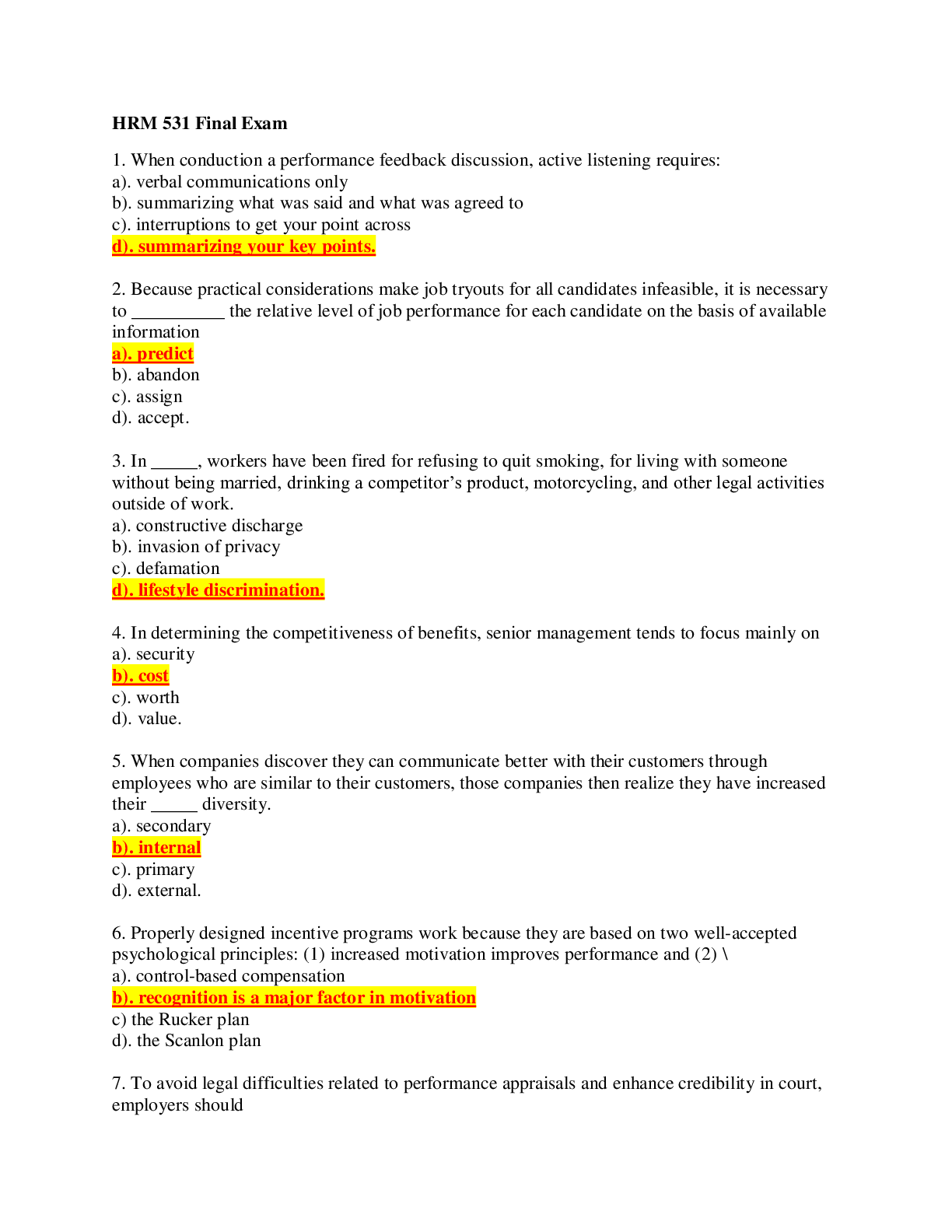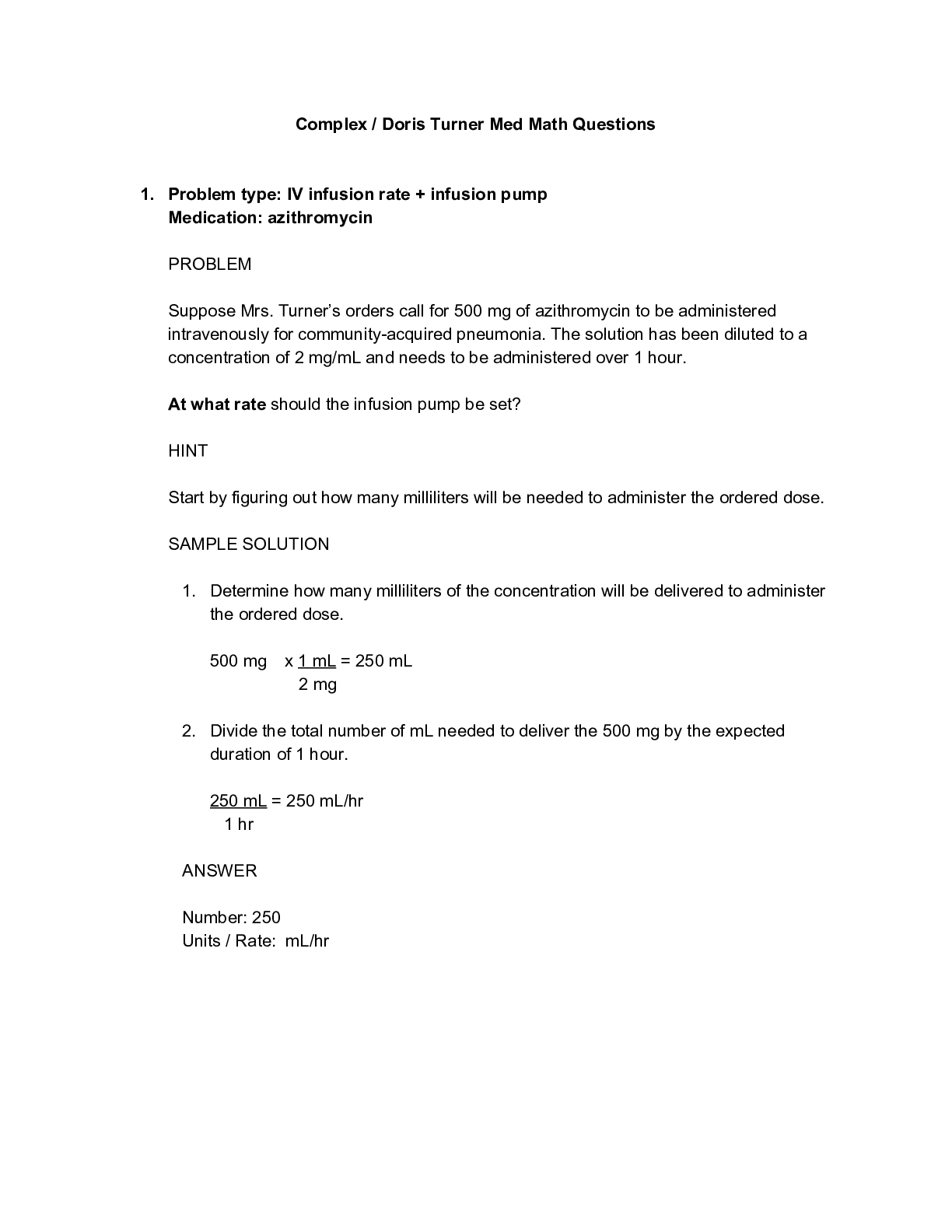Communication > EXAM > CA 110 Final Exam 2022 with complete Solution (All)
CA 110 Final Exam 2022 with complete Solution
Document Content and Description Below
sender - ANSWER the person who talks or sends the message receiver - ANSWER the person who listens or receives the message feedback - ANSWER the information the receiver sends back to the sender... to let the speaker know how well the sender's messages are being understood message - ANSWER the information the sender and receiver send to each other noise - ANSWER anything that interferes with the message exchange between the sender and receiver channels - ANSWER the mediums through which the messages are sent and they can be verbal (radio program) and nonverbal (a newspaper) community - ANSWER a group of people with a common background or with a shared interest public speaking - ANSWER the process of speaking to a group of people in a structured, deliberate manner that is intended to inform, persuade, or entertain listeners encoding - ANSWER to put the ideas or information into specific language the speaker selects to convey his or her ideas decoding - ANSWER means for the listener to interpret the verbal and nonverbal content of a message to give it meaning context - ANSWER where communication takes place shared meaning - ANSWER accomplished when both the sender and receiver have an understanding of the messages delivered in the communication relaxation techniques - ANSWER help you reduce your apprehension by helping you associate relaxed feelings, instead of anxious feelings, with public speaking attitude modifications - ANSWER accomplished by allowing you to complete several lessons on how to develop a speech, and then allowing you to complete drill and practice sessions until you are comfortable with the speech cognitive restructuring - ANSWER a strategy which helps you replace irrational thoughts with rational ones visualization - ANSWER used to help reduce communication apprehension by helping you create, or recreate, sensations associated with your speaking experience ethos - ANSWER the character of the speaker ethical communication - ANSWER fosters "truthfulness, fairness, responsibility, personal integrity, and respect for self and others" trustworthiness - ANSWER combines honesty with dependability pandering - ANSWER merely telling an audience what you think they want to hear or indicating agreement with the audience on all issues when you really don't name-calling - ANSWER the use of abusive words to demean or defame another person plagiarism - ANSWER the act of using another's ideas or language as if it is your own use of an entire work - ANSWER the most obvious kind of plagiarism cut and paste - ANSWER form a plagiarism involving selecting material from several sources, taking them word for word and joining them together in a way that makes sense quoting - ANSWER the use of another's exact words or text paraphrasing - ANSWER the restatement, rewording, or a summary in your own words of what somebody said or something printed in a text ethical listening - ANSWER behaving responsibly when receiving and processing what the speaker is saying audience-centeredness - ANSWER means that you do plan your speech so that it relates to the audience's experience frame of reference - ANSWER our personal set of interlocking facts, ideas, beliefs, values, and attitudes that we use to filter what we hear and then make sense of it if we allow it to register in our brain direct methods - ANSWER interviews, surveys and focus groups where you have personal contact with those from whom you are collecting information focus group - ANSWER a gathering of selected individual participants who are encouraged to talk in an unstructured way about questions posed by a facilitator indirect methods - ANSWER observations, asking people other than group members and reviewing written documents to gather information demographic analysis - ANSWER a technique used to draw inferences about your audience based on categories of information you have available audience demographics - ANSWER age, cultural background, gender, memberships in groups, religion, diversity of sexual orientation captive audience - ANSWER one where the people are required to attend; like your classroom attitude - ANSWER where your audience stands on a continuum from in favor to opposed to your topic and ideas target audience - ANSWER a particular group at which a speech is aimed brainstorming - ANSWER a timed procedure for generating a large number of ideas quickly general purpose - ANSWER to inform, to persuade, or to entertain for special occasions specific purpose - ANSWER should indicate explicitly what you hope to accomplish with your speech, and it should be stated in a single declarative sentence thesis statement - ANSWER the central idea of the speech in a one sentence statement that you want your audience to understand or accept by the end of your speech periodical database - ANSWER provide access to articles from newspapers, popular magazines, and scholarly journals abstract - ANSWER summary of the content of the article written by someone other than the author reference works - ANSWER provide general information about a variety of topics biographical aids - ANSWER references that provide brief life and career facts about contemporary people encyclopedia - ANSWER provides general knowledge about your topic general encyclopedia - ANSWER provides general information about what we know, arranged alphabetically by topic specialized encyclopedia - ANSWER provides in-depth coverage of a particular field of study s yearbook - ANSWER annual publications that report information from the previous year atlas - ANSWER provides maps of the world gazetteer - ANSWER a geographical dictionary internet - ANSWER a global super network linking thousands of computer networks in order to share information search engine - ANSWER finds materials on the internet that you request related to a key word or words based on what you type in the search box blogs - ANSWER web sites or pages that display regular postings by an author or authors-- often in the form of a journal primary question - ANSWER the initial question for an area of your topic follow-up or secondary question - ANSWER use these to discover more in-depth information about the topic clearinghouse question - ANSWER asks the interviewee to talk about something you failed to ask explanation - ANSWER an elaboration on an idea with the purpose of making it understandable and clear definition - ANSWER explains the essential qualities of a word or terminology example - ANSWER a specific case used to represent or illustrate an idea, condition, experience, or a group of people brief example - ANSWER a short, specific instance extended example - ANSWER a narrative or story developed at some length with more detail than a brief example hypothetical example - ANSWER imaginary example based on fact comparison - ANSWER a process of examining two items by pointing out their similarities contrast - ANSWER shows the difference between two or more things, ideas, factors, or issues exercise anorexia - ANSWER takes exercise to the extreme that it becomes dangerous to the person's health statistics - ANSWER numerical ways of summarizing information or facts testimony - ANSWER the statement or declaration of a witness, often used in support of a fact or statement peer testimony - ANSWER support of a fact or statement tat is given by ordinary people like us expert testimony - ANSWER a quotation or paraphrase of a statement by an acknowledged authority in their field open-ended questions - ANSWER questions that require more thought and more than a simple one-word answer closed-ended questions - ANSWER questions which can be answered by a simple yes or no thesis statement - ANSWER the key concept of the speech main points - ANSWER express the key ideas of the speech causal pattern - ANSWER shows the cause and effect of a situation or phenomena; it looks at why something happens and the impact of it chronological pattern - ANSWER organizes main points based on time, sequence, or steps problem-solution pattern - ANSWER establishes a problem or dilemma and offers an answer or fix to the problem or issue topical pattern - ANSWER divides the thesis into subtopics or categories spatial pattern - ANSWER arranges information based on physical space, direction, or location sub points - ANSWER provide proof or evidence to bolster your main points transitions - ANSWER words, phrases, or sentences that connect one idea to the other internal summary - ANSWER a transitional device that gives a thorough recap of the main point before moving on to another idea 2 to 4 - ANSWER appropriate number of main points for a speech [Show More]
Last updated: 2 years ago
Preview 1 out of 27 pages

Buy this document to get the full access instantly
Instant Download Access after purchase
Buy NowInstant download
We Accept:

Reviews( 0 )
$9.00
Can't find what you want? Try our AI powered Search
Document information
Connected school, study & course
About the document
Uploaded On
Oct 17, 2022
Number of pages
27
Written in
Additional information
This document has been written for:
Uploaded
Oct 17, 2022
Downloads
0
Views
46













